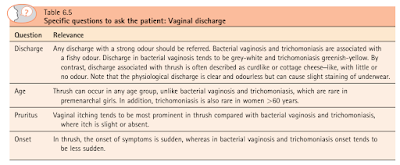Uncomplicated Vulvovaginal Candidiasis
Introduction
- Bacterial vaginosis (most common)
- Vulvovaginal candidiasis (thrush)
- Trichomoniasis
Uncomplicated Vulvovaginal Candidiasis.
The defining feature of vulvovaginal candidiasis is vulval itching. Discharge occurs only in about 20% of patients and if present, it is often described as "curd-like" or "cottage-cheese like" with little or no odour.
- Bacterial vaginosis and trichomoniasis are associated with a fishy odour.
- Discharge in bacterial vaginosis tends to be grey-white and trichomoniasis greenish-yellow.
- The physiological discharge is clear and odourless but can cause slight staining of underwear.
Characteristics of complicated infections include one or more of the following criteria:
- Severe signs/symptoms
- Candida species other than C. albicans, particularly C. glabrata
- Pregnancy, poorly controlled diabetes, immunosuppression, debilitation
- History of recurrent (≥3/year) culture-verified vulvovaginal candidiasis
Treatment
The effective options of uncomplicated vulvovaginal candidiasis include numerous topical agents (usually of the azole class) or fluconazole 150 mg orally as a single dose.
- Imidazoles and triazoles have proven and comparable efficacy, with clinical cure rates between 85% and 90%. Additionally, cure rates between single- or multiple-dose therapy and multiple-day therapy show no differences.
The topical preparations should be administered at night, just before patients going to bed. This allows the medicine time to be absorbed and eliminates the possibility of accidental loss (especially when the person is actively moving). Although systemic absorption is minimal, they may actually damage latex condoms and diaphragms.
In terms of azole pessaries, only clotrimazole 500 mg strength pessary is available inside Ministry of Health Medicines Formulary There is actually three marketed strength of clotrimazole pessary in Malaysia, namely 100 mg, 200 mg and 500 mg. Depends on the strength of the clotrimazole pessary, the duration of clotrimazole differs:
- 100 mg daily for 6 days
- 200 mg daily for 3 days
- 500 mg as a single dose
NOTE: Clotrimazole pessary is under Group C Poisons.
Use of Yoghurt
Some people recommended live yoghurt as a natural treatment. This is based on sound rationale because lactobacilli in the yoghurt produce lactic acid, which inhibits the growth of Candida. However, to date, there is a lack of evidence to prove or disprove this theory.
External Links
- SafeMedication - How to Use Vaginal Tablets, Suppositories and Cream
- Oral versus intra-vaginal imidazole and triazole anti-fungal treatment of uncomplicated vulvovaginal candidiasis (thrush), 2001
- Monday’s medical myth: yoghurt cures thrush, 2013
- The Comparison of Vaginal Cream of Mixing Yogurt, Honey and Clotrimazole on Symptoms of Vaginal Candidiasis, 2015
- Oral versus intra‐vaginal imidazole and triazole anti‐fungal treatment of uncomplicated vulvovaginal candidiasis (thrush), 2020
- Can yogurt treat a yeast infection?, 2021

Comments
Post a Comment